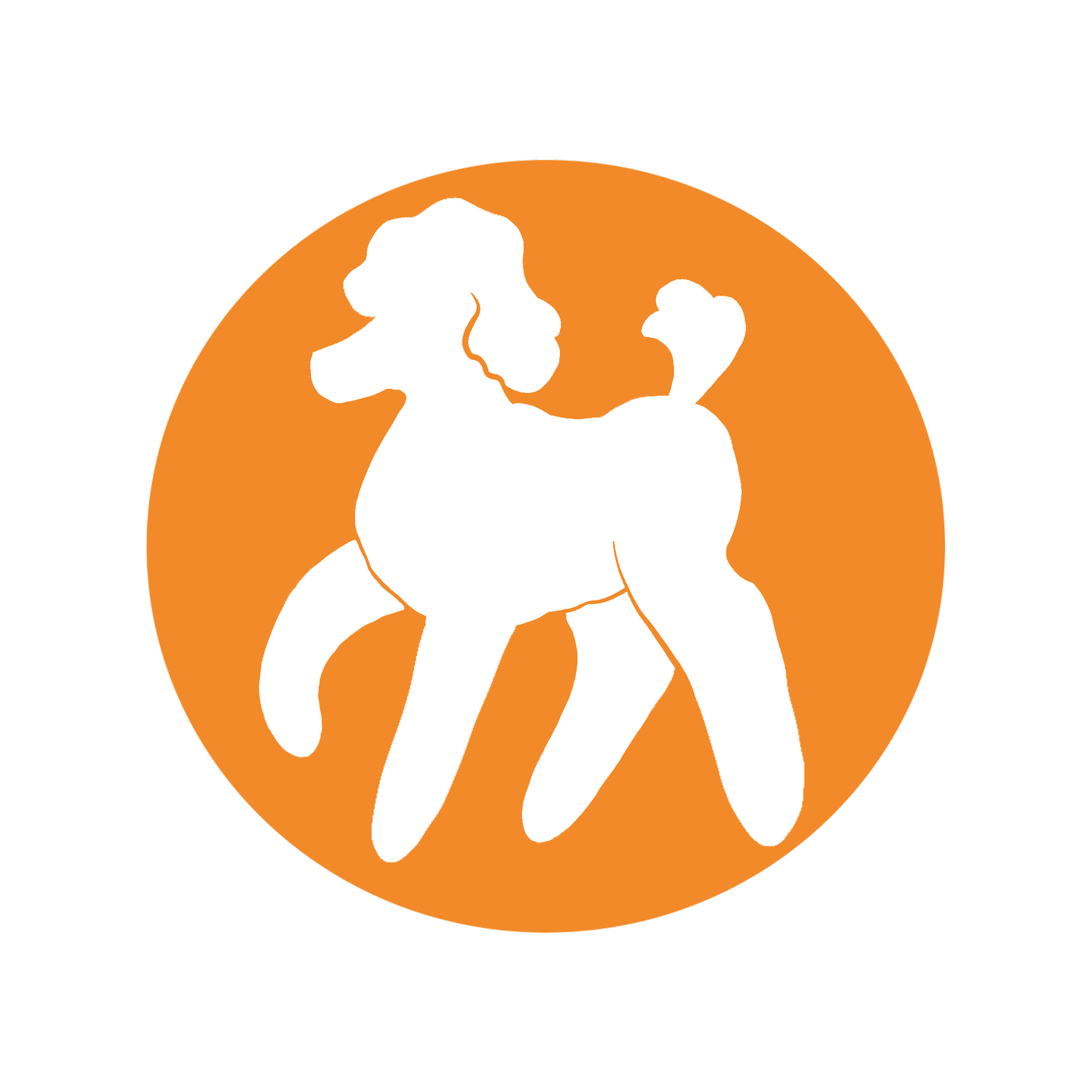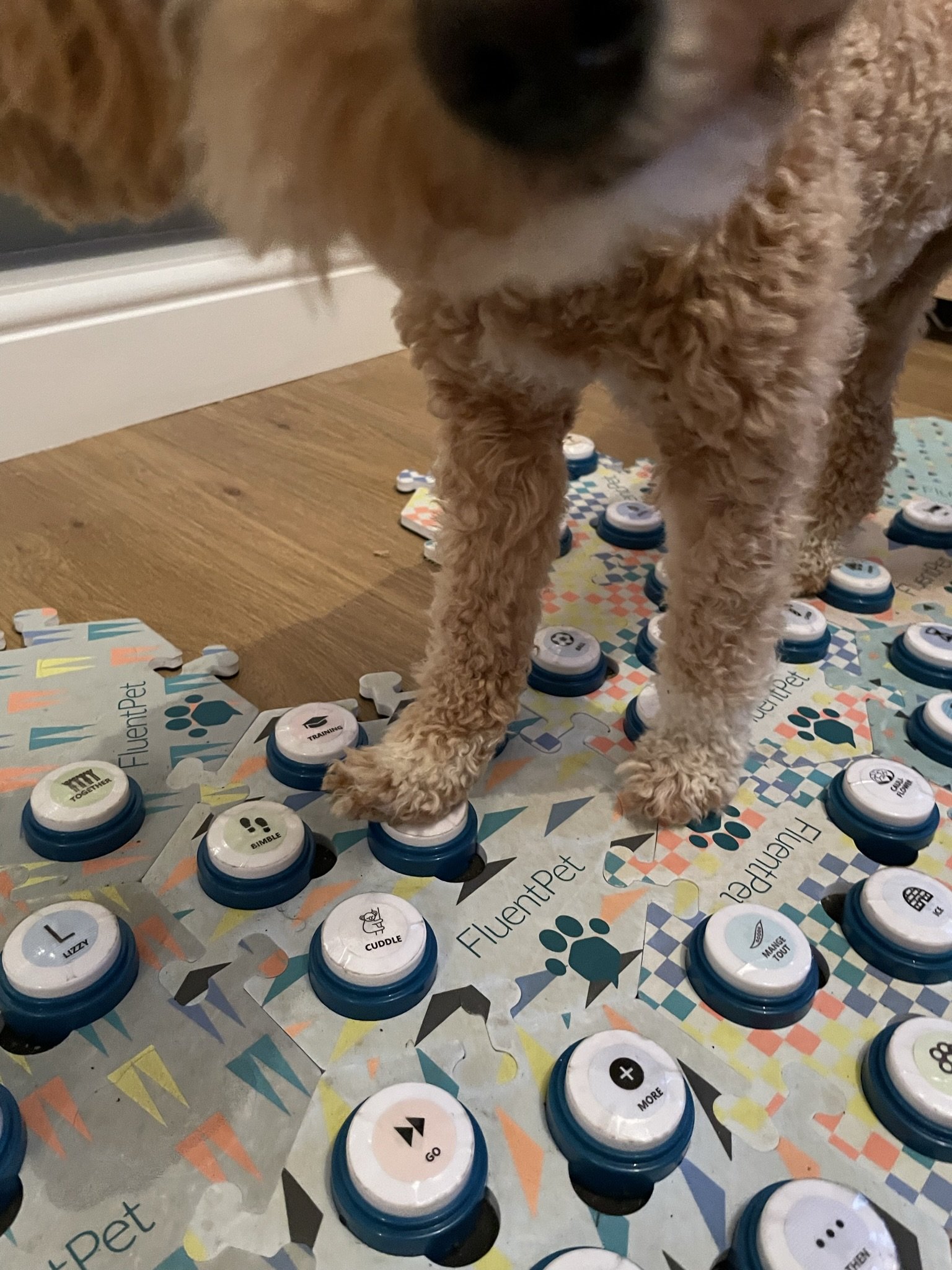Target Practice
If your learner is excited by the buttons but seems to struggle with accuracy or activating the buttons, this is how we suggest you help them.
First things first
Target practice teaches your learner the mechanics of how to push a button. You can use it to build accuracy, teach a small or particularly gentle learner how to put their weight on the button to set it off (this is a common issue with cats), or you can use it to desensitize a learner who is afraid of the buttons. Target practice WILL NOT teach them WHY they should push a button or get them to start pressing the buttons on the board independently. Once your learner DOES know how to activate a button, target practice is done. At that point it just becomes the world’s easiest training game and you can actually slow your learner’s progress by continuing to do lots of targeting sessions.
Some learners press with their paw, some with their nose. Neither is wrong, so let them interact with the buttons in the way that feels most natural.
Don’t do target practice with a learner who is in any way fearful of the buttons unless you’re confident the session itself isn’t causing any fear. Go slowly and stop if they are in any way uncomfortable.
Why are we calling this target practice?
You’ll find some excellent resources online to help teach learners how to press buttons, usually called “target training”, but there are some connotations around the phrase ‘target training’ that we don’t love. This exercise is all about practicing actually pressing a button hard enough to make a noise, and using it accurately. Animal training takes lots of forms and we don’t want you to think of this exercise as being the same as trick training. So, we’re calling it practice rather than training.
Do you need target practice?
Does your learner know a command like putting their paw in your hand to shake, or booping your hand with their nose? Do they confidently move parts of puzzle toys around with accuracy?
Then you might not need target practice at all.
Pushing the buttons isn’t particularly difficult and many dogs and cats can figure it out on their own. Don’t feel like you MUST do target practice just to feel like you’re doing something. If your learner seems confident around the buttons and you’ve seen them activate them without any fear, you can probably skip it entirely or try the food based practice laid out further in this article.
Some learners do struggle to activate buttons, especially cats who are less used to putting their weight on their paws when they play. Some dogs are very clumsy or don’t seem to have great spatial awareness,. These learners might need some target practice to help them on their way.
Practice targeting an object
You can target practice with any object to start. If accuracy is an issue, go big and get progressively smaller. You can use anything from a book to a jar lid to a sticky note. Sticky notes are great because you can start out with a whole note and rips bits off to make the target smaller and smaller.
Select an object to start out with and prepare some rewarding treats or toys (whichever is most motivating to your learner). The object you choose should be something you’re happy for your learner to interact with and that they’re comfortable around.
Show your learner the target object and reward them (with the treat or toy) for any interaction with the object. If your learner is new to this kind of exercise you may have to start out very small by rewarding a glance at the object. Once they figure out that something about the object is getting them rewards, they may move towards it or try to touch it - reward that. If you’re familiar with positive reinforcement training techniques you’ll recognize this as shaping. Reward all these attempts until you get a full on paw or nose press. Once you get that press they get a big jackpot reward. Throw a party. If your learner tries to boop or tap the object right away that’s great! Keep sessions short (5 minutes or less) so that they’re fun and nobody has time to get frustrated. Repeat the exercise a few times until you’re confident they’re confident.
Why aren’t we giving this a cue word or using an existing cue?
It’s important your learner understands that they have the choice to push the buttons or not to push them. You don’t want to accidentally teach them that they should wait for a cue before they interact with the buttons. We know how easy it easy it is to be impatient and use a cue if our learner is being slow to engage with a button, so we think the safest thing is to not use one at all.
Your learner may already know a command like “touch” or “target” that you can use to get them to touch specific things. While we would not generally recommend that you use this command with the buttons, you could consider using it to get them to press the target button once or twice so they can hear it make a noise and see that it isn’t scary. Beyond that initial press or two, do not cue them to push either the target practice button or the buttons on the board.
Target practice with a button
If you have a ‘cue word’ for touching then record that onto your button. You still won’t be using that cue, but it will reinforce the idea that the action is familiar to your learner. If not, use a nonsense word like “boop”. It’s important that it not be a word you plan to use on the board (with one specific exception we’ll go into later).
Repeat the steps in target practicing with an object using your button, eventually only rewarding a press which activates the button. Particularly light or gentle learners may need some additional help to learn that they have to shift their weight over the button. You can do this by waiting for them to put their paw on the button then holding the treat just a little in front of their nose so that they have to lean forward to get it, thus setting off the button.
You can see how this is really similar to an interactive puzzle, and it’s why we don’t recommend starting with buttons next to the objects they represent, or having just one button to begin with.
Can I target train on the soundboard?
Yes! This is easiest to do with a food or treat word, but you could also use a word like “Brush” or “Pets” or “Ball” if those are sufficiently motivating concepts to your learner. Choose something rewarding that you can do over and over.
If your learner is excited by the word you’ve added to the board but is struggling to activate or find the button, here’s what you do.
Use that button to do target practice.
We’ll use the word “Food” here, which means the food/kibble eaten at mealtimes in this example.
This might well take place over several sessions, days or even weeks. Don’t rush this, as it’s preparing the foundations everything else will be built upon.
First, take the food bowl over to the soundboard, and wait for your learner to follow you.
Begin by pressing the button and giving your learner a little bit of food (this is modelling). Repeat the word verbally as you feed them the food. This might need to be one or two pieces kibble at a time to make sure you don’t overfeed your learner. This entire exercise can replace a meal if you need it to.
Repeat this until you start to see signs your learner is anticipating getting the food when you press the button.
Once they’re clearly expecting you to press the button, wait a few seconds. See if they try to engage with the button. This might be a look, movement or gesture toward the button, or an attempt to press. Recognise that with a very excited “Yes!! You want Food??”, press the button and give them the food.
Next, work up to only recognising and rewarding the clearest attempts to press, shaping exactly the same way we outlined earlier with a target object. Once your learner is confident pressing the button you can make your pauses longer and longer.
If your learner is reluctant to press then just model (you might be at that stage for a while). Never ask or direct your learner to press the button, as it should always be their choice.
The above technique was something Lizzy used to encourage Bunny’s first presses. For the record, we think that foods can be a great starter word, as long as you have at least one more button for another activity or object on your soundboard so your learner doesn’t think the buttons are a type of food puzzle (you should always start with more than one word).
Takeaway points
Don’t do target practice near the soundboard unless it’s using a permanent soundboard button.
Go slowly and at your learner’s pace.
Let your learner use a paw, nose or a mixture if that’s how they choose to interact with the buttons.
This will help your learner press accurately and confidently, it won’t make them want to press buttons.


